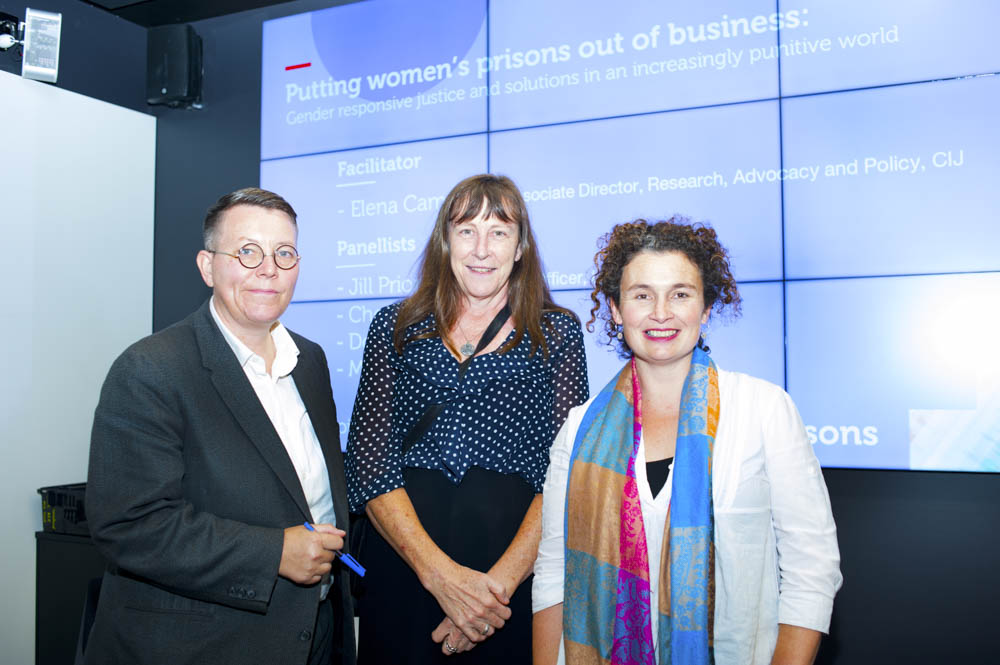The indicators of women’s representation we should be worried about
This International Women’s Day, we will either sigh or celebrate over the progress in women’s representation across important institutions.
L-R Jill Prior, LACW, Magistrate Ann Collins, Elena Campbell, Facilitator and author of blog
This International Women’s Day, we will either sigh or celebrate over the progress in women’s representation across important institutions. ASX listed companies, the law, political life – we will interpret the number of women in these spheres as an indicator of how far we have come on the road to genuine equality.
There is one institution, however, in which women’s representation is rapidly rising. Across Australia – and, specifically, in Victoria – the number of women inside our correctional institutions has been on the rise for some time.
Rather obviously, this indicator is no cause for celebration. It does not tell us how many women commit crime, but instead shows us how many women the community has failed. Study after study has shown that the vast majority of women in any prison have been victims of family violence or sexual abuse, either as an adult, a child, or both. Often this experience propels women into poverty; homelessness; loss of children to out of home care; mental illness; or drug and alcohol addiction – all things we now understand can be drivers for offending.
What is less understood is that the violence that women experience can be a direct driver for criminalisation. Women can be coerced or threatened into offending or assume culpability for their partner’s offences. Women can be arrested for other, unrelated matters due to their poverty and homelessness when they call for police assistance. Women can also be wrongly identified as the primary aggressor at a callout – collateral damage of a zero tolerance approach intended to protect victims, not imprison them.
This week the Centre for Innovative Justice and the Law and Advocacy Centre for Women (LACW) invited an audience to hear from women with the grace to share their lived experience of this trajectory. The audience also heard from a LACW lawyer and a Magistrate who confirmed that they saw this story played out time and again in clients, or in parties before a court. The audience was privileged and devastated to hear accounts of how gendered violence can put women on a direct pathway from victim to criminal, and the repercussions that play out for rest of their lives.
This trajectory is well known to those who have worked with criminalised women for decades. Yet too often, it is not heard in court. Our system is still largely designed only to see the offence, not the offender. It does not always ask and women are often too afraid or ashamed to tell. Women can be arrested, charged, prosecuted and convicted without their experience of victimisation, and its compounding effects, relayed.
Meanwhile, recent reforms to bail and sentencing laws – ironically designed largely in response to acts of extreme violence against women – mean that more women are on remand than ever before. Sentencing options, too, have been curtailed. This means that women charged with a first offence can be just a few steps away from a custodial sentence if they’re unable to comply with other orders of the court.
And compliance with court orders can be incredibly difficult for women who are homeless; who have a mental illness or drug and alcohol addiction; or who have a cognitive impairment or Acquired Brain Injury, including as a result of the violence they have experienced.
Meanwhile, women funnelled along this violence to prison pipeline will too often be released into homelessness and without any support – despite all the programs we profess to offer. Women in this situation are then even more vulnerable to violence; offending and sometimes to loss of life.
This pipeline has devastating effects not just for the women concerned, but for their children who, once removed, are more vulnerable to violence or offending themselves. This means multiplying costs to the community down the track.
Yet the solutions are not rocket science. The provision of appropriate support; proactive justice interventions; safe and stable accommodation – all these cost less than it does to build more prisons. What’s more, they have far more positive results.
This International Women’s Day, we should examine all the meaningful indicators. Whether or not there are more women in ASX listed companies, the rising number of women in our prisons is a flashing light on the dashboard that something is seriously wrong. It means we have failed to respond appropriately to gendered violence; that we have failed to perceive the compounding impact of a gendered justice response.
Given what we know about the drivers for women’s offending, a truly positive measure of our progress towards gender equality will be if we can eliminate the need for a women’s prison at all.
Elena Campbell
Associate Director – Research, Advocacy and Policy
Centre for Innovative Justice
